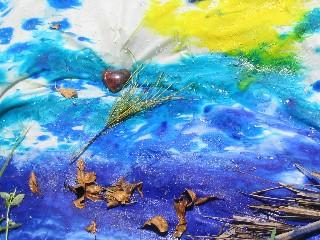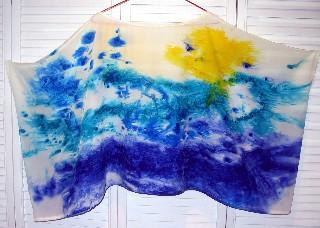 Making a hand painted silk crepe poncho inspired by the art glass necklace I made last week, was the most fun I've had doing something new to me in a long time!
Making a hand painted silk crepe poncho inspired by the art glass necklace I made last week, was the most fun I've had doing something new to me in a long time!I bought some Seta Color transparent fabric paints from Dharma Trading Company
http://www.dharmatrading.com/sunpainting/ a couple of years ago, but never had the courage to try anything with it. Thanks to the soft urgings of Susan Sorrell, my muse, http://creativechick.blog-city.com/ I decided to use up the, by now, thickened and almost too old paint. If it didn't work out, I really had nothing to lose but a few hours of time outside in the South Florida sun.
After washing the crepe silk http://www.thaisilks.com/ in the washing machine, in warm water, to shrink it and prepare it to more easily accept the paint, I spread the two yards of wet fabric out on the grass in my front yard. I used three shades of blue and some golden yellow fabric paints. All had to be diluted with water because they were so dried out, thickened to the consistancy of tomato paste.
As soon as I had the fabric weighted down, I started to drip and drizzle and smear the paint with my hands.

After that I threw kosher salt at it. Kosher salt is great because it comes as big, fat chunks of salt which causes the dye or paint molecules to gravitate toward it. This makes a very interesting pattern as the paint dries. I also tossed on some dried leaves, heart shaped rock crystals, and dried palm branches.

The grass was rather long and made the surface of the fabric roll unevenly. The salt collected in patches and the paints migrated according to the hills and valleys of this uneven surface.
It was great!
Never before have I allowed myself such freedom in creating! I have used a lot of silk dyes for the prayer shawls that I have made in the past 12 years, but the fabric always had to be stretched out tightly on large frames. Then steamed for three hours to set the dye and then there was a trip to the dry cleaners to remove the gutta resist. I never liked the water soluble resists as I just couldn't get them completely washed out of the fabric. And, unfortunately, I found that within a couple of years, the colors would begin to fade if I had hung a finished piece, like a marriage canopy, on a wall in my sun drenched south Florida home. It was dissatisfying, to say the least! I guess, I didn't use the fabric paints because I was afraid the results would be less intense and just as much work.
Boy was I wrong! And, boy am I glad.
The paint and fabric was dry within two hours. The sun was shining brightly maybe half the time, making the possibility of a clear sunprint of the solid objects laid on the paint, dim. Plus, the paint, as I have said too many times before, was old. But the results, to my eyes, were spectacular!
It was with much excitement that I picked up that piece of silk and took it to my ironing board to set the paint with the iron high on the "cotton" setting. I ironed both sides of that silk. And, I didn't let the fact that the fabric was now as stiff as a paperback cover bother me. I was going for the gold! That paint was gonna set, come heck or high water!
Immediately after ironing it, I dunked it in a pail of water and rinsed and rinsed. Now this is the part that usually brings tears of frustration to my eyes when working with silk dye. I have found that it is IMPOSSIBLE to rinse steamed and dyed silk and not have at least some back staining on the fields of white. There are always free dye molecules just looking to attach to something!
Ah, but this paint stuff. It's amazing. Sure there were extra layers of paint that did not attach to the fabric. But, you know what? They just floated in small clumps and rinsed right down the drain. Not ONE small particle decided to set up housekeeping on my white silk. Zowey!
Later that evening, I cut out the pattern and sewed it together, doing nice folded seams and all that jazz. It was a pleasure! The hand of the silk was smooth and soft and as silky as if it had never been abused at all. And, the colors did not wash out or get pale in the rinse bucket. The cobalt was as rich as the necklace that started it all.
Next day I wore it to lunch with a friend and followed that up with three hours of errands. Mucho compliments came my way - all spontaneous, of course!

It's good to be happy.







